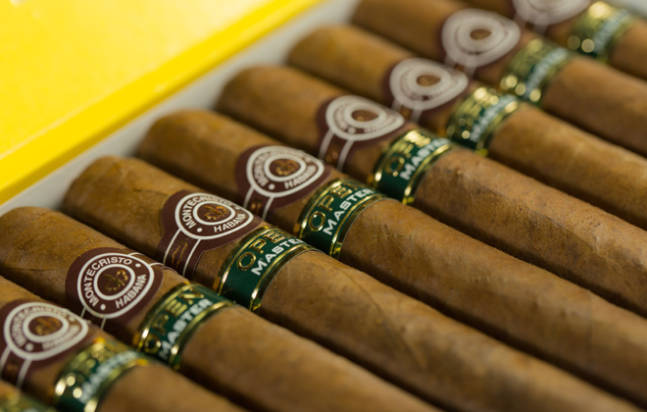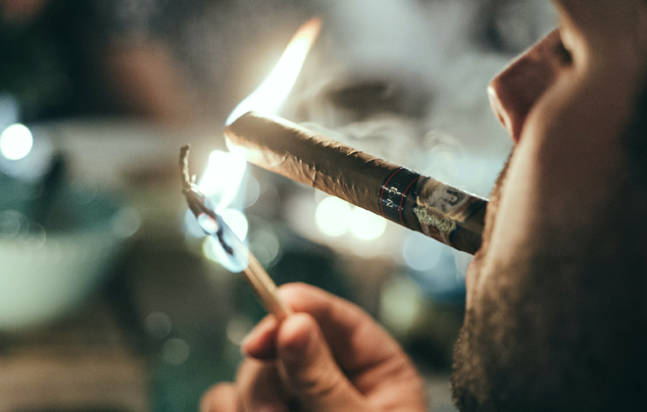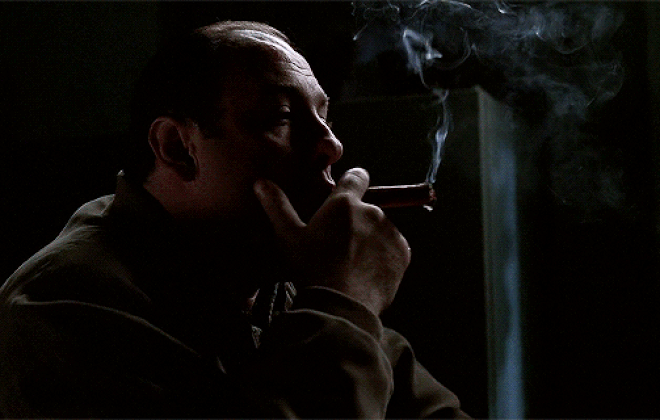A good cigar is easily one of the finer things in life, but smoking one isn’t intuitive. The entire experience is an art, and even the smallest error can change the way the cigar tastes and smokes. Done properly, a well-cut and properly lit cigar can slow time down, cement friendships, and pull you away from the busyness of life. Moderation is the key, so when you light up, make it count. Without the proper guidance, you will absolutely come off like a cigar noob. It’s vital to initiate the process armed with the knowledge of how to actually cut, light, and smoke a cigar the right way.
Cigars 101
We’ll start out by saying that it never involves your teeth, a road flare, or inhaling forces only reserved for siphoning gas. You’ll also need the right tools to both do the job and look the part. You may never look as debonair as Tom Selleck puffing on a Cuban Montecristo No. 2, but you should certainly make the effort. Here’s our primer on how to smoke a cigar like a seasoned pro.

How to Pick Out Your Cigar
If you know nothing about cigars, there’s plenty of information on the internet, but it can be overwhelming. If you’re a first-time cigar smoker, it’s best to start out with a mild-bodied cigar that won’t punch you in the tastebuds. Avoid machine-made cigars that are typically sold behind the counter at gas stations or convenience stores, and also steer clear of flavored cigars that fail to impart the true tobacco leaf smoke experience but instead pummel you with cloying sweetness.
Our Favorite Cigar Brands
The compendium of good, high-quality smokes is deep, and wide, and tall. If you’re new to cigar smoking, a mild-bodied, Connecticut Shade wrapper cigar is best. If you’re up for something stronger, aim for a Ligero, Sumatra, or Maduro wrapper. These are darker and fuller-bodied and are best smoked after a meal and with a robust glass of wine or Port, a cup of coffee, a glass of bourbon, or a single malt scotch. If you can’t get any good help in selecting a cigar, some of our favorite smokes come from:
- Ashton
- Romeo y Julieta
- Padron
- Alec Bradley
- Tatuaje
- La Flor Dominicana
- La Aroma de Cuba
- La Gloria Cubana
- Arturo Fuente
- Perdomo
- Montecristo
- Davidoff
Also, keep in mind that you don’t have to buy the most expensive, handmade cigar to have a great smoking experience. A $10 Romeo y Julieta Reserve Churchill is one of the best non-Cuban smokes we know of, rivaling $25 sticks. The more you expand your cigar palate, the more knowledge you’ll gain about brands, tobacco leaf types, sizes, and shapes. Take notes on the cigars you’ve smoked and which ones stand out.

How to Cut Your Cigar to Get The Most Out Of It
How you cut your cigar depends on its shape, first and foremost. For the purposes of this primer, we’ll go with the most common type of cigar that has a rounded head (the part that you smoke) with a cap. A well-made cigar typically has a very smooth cap that’s actually the only part of the cigar that’s adhered with vegetable-based glue. If you cut below this cap line, the cigar will start to come unraveled as you smoke, if not immediately. This can ruin the cigar smoking experience because bits of tobacco will end up in your mouth, and the wrapper will come undone, which affects the taste, as well as how it smokes.
- Step 1: Use a straight, two-finger guillotine cutter with curved blades. Avoid the single, straight blade because it can crush the head on one side or create an uneven cut, especially if it’s not razor sharp. You don’t need an expensive cutter to get a precise cut, but high-quality versions from Davidoff, Dunhill, Xikar have actual warranties and have proven themselves for years. You can still get good cutters on Amazon and at most cigar shops. Prior to cutting the cigar, make sure it has been properly humidified. A dry cigar will feel overly firm to the touch and should not be smoked because it will likely crack and split when it is cut and smoked. An overly moist cigar will be spongy and can fail during the cutting process due to a wet wrapper. A properly humidified cigar will have some give to it, and it will feel mildly soft to the touch but should remain firm.
- Step 2: Open the cutter all the way, and insert the head of the cigar. While you hold the cigar, cut off a small amount, ensure you are cutting well above the cap line.
- Step 3: Now, check the draw to see if you can get enough air through the cigar without trying too hard. If the draw is strained, then very carefully shave off a bit more. Remember, you can always take off more with the cutter, but you can’t put it back on if you cut too much. Under no circumstances should you cut below the cap line. Stay with this rule, and you should be fine even if the cigar doesn’t have the ideal draw.

How to Properly Light Your Cigar
But first, what lighter to use?
When it comes to lighting cigars, you should only use a wood match, a thin strip of cedar, or a butane lighter. None of these will impart any chemical flavor and are relatively neutral. Avoid using cardboard matches or lighters that use lighter fluid because they will change the way your cigar tastes. A wooden cigar match might be the easiest lighting tool to come by. But, a butane torch lighter or is ideal because it provides the best flame control when lighting. If you already have one, a Zippo lighter is a good choice as well. If you do use a Zippo, make sure you get yourself the butane lighter insert as a standard Zippo uses lighter fluid. Never touch the foot of the cigar (the opposite of the end that goes in your mouth) with the actual visible flame because you will singe the wrapper and turn it black. This also affects the way your cigar tastes. Also, don’t crank up your lighter all the way to F-14 fighter jet afterburner mode. Turn it down to about halfway. This decreases the likelihood that you’ll burn the wrapper.
Now, onto how to light a cigar. Without putting the cigar in your mouth just yet, gently toast the cigar foot:
- Step 1: Hold the cigar in your hand at between a 45- and 60-degree angle to the flame.
- Step 2: Hold the foot at least a couple of inches away from the tip of the flame.
- Step 3: Move the lighter in a circular motion and also rotate the cigar to toast the entire area of the cigar’s foot.
This isn’t just ritual. What you’re doing is ensuring that the entire area of the foot is lit, including the wrapper, the binder, and the filler tobacco. This is, in fact, the proper way to light a cigar. The wrapper provides the most flavor and toasting unleashes all that flavor. If you simply light the foot with the cigar in your mouth, you’re probably just igniting the filler leaf and missing out on the entire flavor profile of the cigar. Toasting the foot also allows a more even burn while smoking, another important facet of the entire experience. You can also blow on the foot gently to help permeate the burning orange glow. Once you’ve done this, let the cigar sit for a minute to rest. Be patient. The best part is about to begin.

How to Smoke Your Cigar
If your cigar is well-constructed, it may still be lit after letting it rest for a minute. If not, carefully and lightly re-toast the foot. You can now smoke it by drawing air in gently but don’t inhale (ever). Cigar smoke is about flavor and not about filling your lungs with smoke as you might with a cigarette. Draw the smoke into your mouth and let it fill it with rich flavors. Allow the smoke to escape without blowing hard. Be careful not to draw in too much air or to draw smoke in too often so as to render the cigar overly hot within the filler tobacco. Not only does an overly hot cigar affect the taste negatively by allowing too much tar to build up at the tip, it can also mess with its construction, and the cigar can start to come apart or split, especially if it is even slightly on the dry side.
Take your time when smoking a cigar.
Smoking a cigar is never meant to be rushed, and that’s the whole point of it all, to relax. Some smokers choose to remove the cigar brand’s paper band, a matter of preference. If you do choose to remove it, wait for a little while before doing so because it gives the band and glue time to warm up. This way, you can remove it more easily and avoid tearing the thin wrapper.
Draw the smoke in gently, let it sit for a moment and slowly let the smoke out. As you taste the smoke, you should be able to pick out notes on both the nose and palate, not unlike a good wine. Flavors like wood, leather, pepper, vanilla, dark chocolate, dried fruit, and even bread dough will peek out. Cigars can also change as you smoke them. Sometimes a cigar that seems very one-dimensional in taste at the start can morph into a symphony of complexity. If you need to re-light your cigar if it’s gone out, do so carefully.
How about relighting the cigar?
When it comes to relighting, just make sure you don’t do it too often. It’s not good for the taste or temperature of the cigar. Take notes if you want to. How was the construction of the cigar, the draw, the burn, the flavor? It’s a great way to track what you’re smoking so you can make good choices later on. Also, don’t be afraid to place the cigar down from time to time in order to let it breathe and cool down. What you don’t want to do is ash a cigar like you would a cigarette or a joint. Instead, place it gently on an ashtray and roll the cigar from side to side allowing the ash to softly fall off.
Congrats! You’ve officially completed our guide to smoking and lighting a cigar. Now, take a sip of your favorite beverage and enjoy the moment — the time and place you’re in. Take comfort in knowing you’ve done it right, and it only gets better from here.




